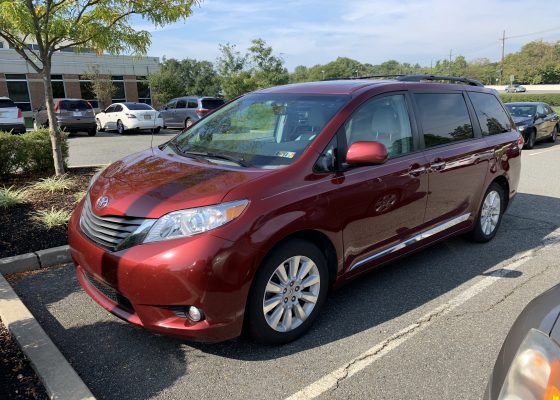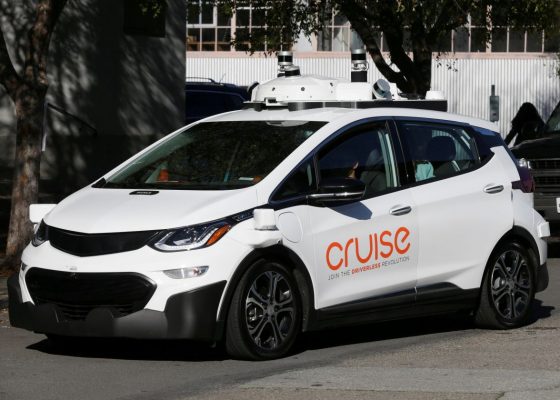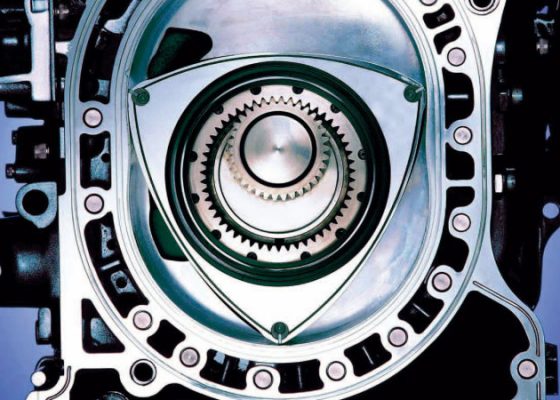Review: 2010 Toyota Highlander Hybrid Limited
By Chris Haak
Rarely does my wife get excited about new cars coming to the Full Metal Autos Garage for week-long reviews. She’s just not a car person. I also would not exactly call her reaction to the news that a Highlander Hybrid was coming anything approaching “excitement,” but she at least perked up. After all, I said the magic word: “Hybrid.” Oh, and the other magic word too: “Toyota.”
Like the Prius, the Highlander Hybrid’s mission is to consume less fuel. Everything about the driving experience – handling, acceleration, steering, and braking – is secondary to that. The Prius also carries the mantle of Toyota’s market leadership in hybrids and is the company’s green halo car, so has a shape that broadcasts the owner’s environmental friendliness to the rest of the world, for better or worse. The Highlander Hybrid, on the other hand, is barely distinguishable from a standard Highlander, save for a HYBRID emblem on each front fender, a small Hybrid Synergy Drive emblem on the rear hatch, and a different grille. So what does this focus on fuel economy mean to the driving experience?
 Let’s just say that the Highlander Hybrid did not make a favorable first impression on me on the road. Only after a day of driving with the “ECO” button pressed, and playing around with it, did I realize how harmful that button is to the Highlander Hybrid’s throttle response. With the vehicle in Eco mode, throttle response is dulled to the point that it doesn’t even feel like a V6-powered vehicle anymore, at least initially. Passing power in Eco mode is sufficient, and aided by the electric motors.
Let’s just say that the Highlander Hybrid did not make a favorable first impression on me on the road. Only after a day of driving with the “ECO” button pressed, and playing around with it, did I realize how harmful that button is to the Highlander Hybrid’s throttle response. With the vehicle in Eco mode, throttle response is dulled to the point that it doesn’t even feel like a V6-powered vehicle anymore, at least initially. Passing power in Eco mode is sufficient, and aided by the electric motors.
Then, once I finally turned off Eco mode, it was almost a revelation. The vehicle was so much more enjoyable to drive, at least in terms of throttle response. The Highlander no longer resisted acceleration; it just did it. It isn’t blazingly fast, mind you, but about on par with what you’d expect to feel from a modern V6-powered midsize crossover. The best part is, there was little-to-no discernible penalty in observed fuel economy when skipping Eco mode.
 As I’ve done with every hybrid I’ve reviewed, I paid much more attention to the car’s reported average fuel economy than I typically would in a conventional car. It’s pretty easy to keep the Highlander Hybrid’s average fuel economy in the low-20s, and with conservative throttle application (not quite to the extent of hypermiling) making it possible to beat the EPA’s estimates of 27 city/25 highway. During over 600 miles of mixed (though mostly highway driving), I got about 25 mpg combined, but two days of conservative driving following a fill-up resulted in a 28 mile per gallon average. Coupled with the Highlander Hybrid’s 17.2 gallon fuel tank, driving range is upwards of 430 miles on a single tank of regular unleaded.
As I’ve done with every hybrid I’ve reviewed, I paid much more attention to the car’s reported average fuel economy than I typically would in a conventional car. It’s pretty easy to keep the Highlander Hybrid’s average fuel economy in the low-20s, and with conservative throttle application (not quite to the extent of hypermiling) making it possible to beat the EPA’s estimates of 27 city/25 highway. During over 600 miles of mixed (though mostly highway driving), I got about 25 mpg combined, but two days of conservative driving following a fill-up resulted in a 28 mile per gallon average. Coupled with the Highlander Hybrid’s 17.2 gallon fuel tank, driving range is upwards of 430 miles on a single tank of regular unleaded.
As with Toyota’s other hybrid models, the Highlander has an EV button. While its actual utility is questionable, it does make for a somewhat entertaining way to pass time in very slow traffic. If the engine is warm and the hybrid battery is sufficiently charged, the vehicle may decide to allow you to drive on electric power only up to 27 miles per hour. There were countless times that I was either told by the system that EV mode was unavailable (without an explanation) or was booted out of EV mode for “excessive speed” (after hitting a breakneck 28 miles per hour) or “excessive throttle application” (daring to go beyond roughly 10 percent throttle application). But in bumper-to-bumper traffic, EV mode actually allowed me to often increase the average fuel economy. Too, the button is handy for occasions on sunny days when I had to run into a store quickly and left my wife in the car with a sleeping child; tapping the EV button before leaving the car ensured that the electric air conditioning continued to work without wasting the fuel that idling typically would.
 The interior of the Highlander Hybrid Limited made a good first impression on me. I’m a sucker for leather seats and wood trim in colors or textures that are a little off the beaten path. In the case of this vehicle, the wood trim was a much lighter shade than is typically found in most cars. There are no shiny hard plastic surfaces in the Highlander’s interior, and the navigation display is large and conveniently placed. Also, controls are all large and reasonably easy to use, and feel good in one’s hand. Unfortunately, the wood trim is extremely fake-looking up close (to the point that the actual “grain” shows visible pixels) and there is hard plastic (albeit not shiny, hard plastic) nearly everywhere that isn’t a seat or armrest. The headliner is the cheap cardboard type found in a $16,000 Corolla, and is completely out of place in a $46,000 semi-luxury crossover.
The interior of the Highlander Hybrid Limited made a good first impression on me. I’m a sucker for leather seats and wood trim in colors or textures that are a little off the beaten path. In the case of this vehicle, the wood trim was a much lighter shade than is typically found in most cars. There are no shiny hard plastic surfaces in the Highlander’s interior, and the navigation display is large and conveniently placed. Also, controls are all large and reasonably easy to use, and feel good in one’s hand. Unfortunately, the wood trim is extremely fake-looking up close (to the point that the actual “grain” shows visible pixels) and there is hard plastic (albeit not shiny, hard plastic) nearly everywhere that isn’t a seat or armrest. The headliner is the cheap cardboard type found in a $16,000 Corolla, and is completely out of place in a $46,000 semi-luxury crossover.
In terms of features included in the Limited model, most of the expected high-tech infotainment choices are present – or available. It was somewhat disappointing that a top-of-the-line Highlander with navigation and everything else was pre-wired for XM Satellite Radio (including having a shark fin antenna on the roof ), but does not actually have an XM receiver, meaning that the “AM/SAT” button next to the navigation screen does nothing but switch to AM radio. The Highlander also does not have Bluetooth streaming audio, as do many other Toyota and Lexus models.
 The Highlander does have a small color LCD info screen at the top of the dash for the trip computer and climate display. This display has very high resolution, but is only about three inches diagonal, versus about nine inches for the regular navigation screen. Since this display is standard, Highlanders not equipped with navigation use it for the backup camera display, but in navigation-equipped models like my tester, the rear camera is displayed on the larger navigation screen instead. I’m sure that Toyota saved some money by eliminating redundant temperature and fan setting displays elsewhere on the center stack, but it was somewhat annoying to have to either switch the readout to display climate control information, or adjust the temperature or fan speed just to see what the HVAC settings were. The 2011 Sienna uses a similar supplemental LCD display, but – perhaps because it is not a hybrid – displays HVAC information constantly using the top three-quarters of the screen, and the trip information (average mpg, instant mpg, range to empty, etc.) on the bottom quarter of the screen.
The Highlander does have a small color LCD info screen at the top of the dash for the trip computer and climate display. This display has very high resolution, but is only about three inches diagonal, versus about nine inches for the regular navigation screen. Since this display is standard, Highlanders not equipped with navigation use it for the backup camera display, but in navigation-equipped models like my tester, the rear camera is displayed on the larger navigation screen instead. I’m sure that Toyota saved some money by eliminating redundant temperature and fan setting displays elsewhere on the center stack, but it was somewhat annoying to have to either switch the readout to display climate control information, or adjust the temperature or fan speed just to see what the HVAC settings were. The 2011 Sienna uses a similar supplemental LCD display, but – perhaps because it is not a hybrid – displays HVAC information constantly using the top three-quarters of the screen, and the trip information (average mpg, instant mpg, range to empty, etc.) on the bottom quarter of the screen.
I was not particularly impressed by the Highlander’s JBL stereo; in spite of being a brand name and having a subwoofer and a fairly-high speaker count (nine), it did not provide expected levels of clarity or power, particularly at higher volumes. Audiophiles, which I am not really one, would probably scoff at the suggestion of using a Bose-provided speaker system in the Highlander, but my experience with Bose has been that it would be an improvement over the JBL system.
 On the road, once I sorted out the “ECO” button, the driving experience was fine, other than steering and braking. The power steering, as in other hybrids, is electrically-powered so it works when the engine is not running. Some cars, like the Ford Fusion Hybrid, do a pretty good job of disguising the artificial feelings often present in EPS systems. Unfortunately, the Highlander Hybrid does not do so. Steering effort is very light, the ratio is slow, and at times it was a little difficult to point the front end where you intend to at first. With practice, it eventually becomes more or less a non-issue.
On the road, once I sorted out the “ECO” button, the driving experience was fine, other than steering and braking. The power steering, as in other hybrids, is electrically-powered so it works when the engine is not running. Some cars, like the Ford Fusion Hybrid, do a pretty good job of disguising the artificial feelings often present in EPS systems. Unfortunately, the Highlander Hybrid does not do so. Steering effort is very light, the ratio is slow, and at times it was a little difficult to point the front end where you intend to at first. With practice, it eventually becomes more or less a non-issue.
The brake pedal is hard to press down, and most normal braking is done without the mechanical rotors and pads that other cars have; instead, the Highlander Hybrid uses its electric motors for regenerative braking. Regen braking slows the car and converts some momentum back to electrical energy that goes into the battery pack. Handling behavior was hampered somewhat by the vehicle’s tire choice; in spite of being fairly large (P245/55R19), they didn’t seem to offer very much grip. Coupled with the somewhat-flaky steering, I didn’t bother any corner carving. The fairly-flat driver’s seat didn’t encourage such behavior either; neither did the hard plastic on the door panels and to the left of the center console where I’d have to brace my knees for any corner-carving.
 The Highlander Hybrid has an Atkinson cycle 3.3 liter V6 that produces 209 horsepower at 5,600 RPMs and 212 lb-ft of torque at 3,600 RPMs. The Atkinson cycle design improves efficiency at the expense of specific output, but the gasoline engine’s output is supplemented by no less than three electric motors. One serves to start the engine, control the transmission’s ratio, and generate electricity, but is not rated for its output. The other motor connected to the front wheels produces 167 horsepower at 2,300 RPMs and 247 lb-ft between 0 and 1,500 RPMs. Finally, there is a motor connected to the rear wheels to provide all wheel drive. (The Highlander and Lexus RX 450h hybrids do not have a physical driveshaft to power the rear wheels; they are purely driven by electricity when called upon). The rear motor produces 68 horsepower and 96 lb-ft. Overall, the net power output of the hybrid system is 270 horsepower, when taking power curves into account.
The Highlander Hybrid has an Atkinson cycle 3.3 liter V6 that produces 209 horsepower at 5,600 RPMs and 212 lb-ft of torque at 3,600 RPMs. The Atkinson cycle design improves efficiency at the expense of specific output, but the gasoline engine’s output is supplemented by no less than three electric motors. One serves to start the engine, control the transmission’s ratio, and generate electricity, but is not rated for its output. The other motor connected to the front wheels produces 167 horsepower at 2,300 RPMs and 247 lb-ft between 0 and 1,500 RPMs. Finally, there is a motor connected to the rear wheels to provide all wheel drive. (The Highlander and Lexus RX 450h hybrids do not have a physical driveshaft to power the rear wheels; they are purely driven by electricity when called upon). The rear motor produces 68 horsepower and 96 lb-ft. Overall, the net power output of the hybrid system is 270 horsepower, when taking power curves into account.
My tester was a all wheel drive Limited model, with a base price of $41,820 including its $800 destination charge. The only options on it were the $2,775 touch-screen navigation system with JBL audio, Bluetooth handsfree telephone connectivity, the $220 anti-theft alarm system with engine immobilizer, the $49 cargo net, and the $2,010 Highlander Hybrid Limited Extra Value package with automatic dual-zone front and automatic rear air conditioning, plus a power tilt/slide moonroof. Out the door, the MSRP was $46,174 (after a $700 MSRP discount associated with the extra value package).
 Though the driving experience in the Highlander Hybrid leaves much to be desired to those used to more conventional drivetrains, the vehicle does an excellent job of hitting its advertised fuel economy numbers. Considering that a standard Highlander with a 3.5 liter V6 and AWD is rated a full 10 miles per gallon worse in the city (17 mpg vs. the hybrid’s 27), the numbers that it puts up are an impressive 58 percent better. Combined, the hybrid tops the regular Highlander’s fuel economy by 37 percent. Considering that my wife’s 2008 Sienna AWD, which weighs more but has a similar drivetrain, gets combined fuel economy of around 17 miles per gallon, the hybrid’s numbers are impressive.
Though the driving experience in the Highlander Hybrid leaves much to be desired to those used to more conventional drivetrains, the vehicle does an excellent job of hitting its advertised fuel economy numbers. Considering that a standard Highlander with a 3.5 liter V6 and AWD is rated a full 10 miles per gallon worse in the city (17 mpg vs. the hybrid’s 27), the numbers that it puts up are an impressive 58 percent better. Combined, the hybrid tops the regular Highlander’s fuel economy by 37 percent. Considering that my wife’s 2008 Sienna AWD, which weighs more but has a similar drivetrain, gets combined fuel economy of around 17 miles per gallon, the hybrid’s numbers are impressive.
The Highlander Hybrid manages to almost make a game of driving economically, which high-horsepower cars discourage. The ride is comfortable and the seats are of reasonably-good leather quality. Visibility is good in all directions, and the third row – while small – is reasonable for children, or can be folded for a decently-sized cargo area. After several extended road trips in this test Highlander Hybrid, and listening to me complain about the trade-offs in the driving experience, I asked my wife if she’d buy a Sienna Hybrid if/when Toyota decided to offer one. I’m sure you know what the answer was: yes.


